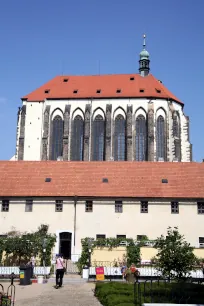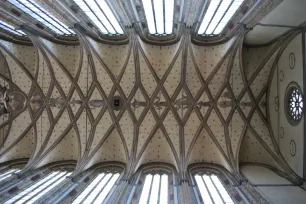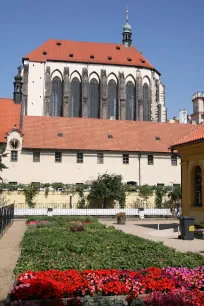The Church of Our Lady of the Snow was founded in 1347 by Charles IV on the occasion of his coronation as King of Bohemia in September that year. The church was to rival the Cathedral of Saint-Vitus in size.

However, wars and financial troubles prevented this vision from ever being realized. Only the chancel was completed, and this forms the church as we see it today.
The Legend of the Snow
The name of the church refers to a medieval legend linked to the construction of the Basilica of St. Mary Major in Rome. According to the legend, both a Roman patrician and the pope had the same dream in which the Virgin Mary appeared. She ordered them to construct a church on the site in Rome where, on the night of August 4-5, snow would fall. This led to the name ‘Lady of the Snow’, and it also explains why the dedication of the church in Prague is celebrated on August 5.
History
Construction
In 1346 the Carmelite Order received permission to build a church and monastery in Prague. Its cornerstone was laid by Emperor Charles IV on September 3 the following year, the day after he was crowned King of Bohemia.
Decline

The church was to be about 110 meters long (360 feet) but shortly after the chancel and a large bell tower were completed in the early 1400s, the Hussites – followers of reformer Jan Hus – started to plunder churches including Our Lady of the Snow. During the Hussite Wars that followed, the bell tower was destroyed. The Carmelites fled and construction came to a halt. Disaster struck again in 1542, when part of the roof collapsed. The church started to fall into disrepair and by the end of the sixteenth century three walls were all that was still standing.
Restoration
In 1604 the Franciscans acquired the complex and just three years later they started with the reconstruction of what was, at that point, nothing more than a ruin. Despite another attack on the church in 1611 the church was rebuilt in Renaissance style and consecrated in 1625. The Franciscans built a new roof and added a three-winged ambulatory. The Baroque interior that we see today was added later that century.
The Church
Courtyard


To reach the church, walk through the colonnaded archway right behind the statue on Jungmann Square. This brings you to the courtyard, which is situated where the nave was supposed to be. It gives you an idea of the size of the planned church.
In the courtyard stands a Baroque statue of St. Anthony of Padua from the late 17th century. There are also statues of St. John of God and St. John of Nepomuk, both works from the early 18th century by the Czech sculptor Jan Oldřich Mayer, who also created several of the sculptures on the Charles Bridge.
Interior
Inside, you’ll immediately notice the rather unusual proportions of the church: short in length but immense in height.
The interior is lavishly decorated in the Baroque style, and the massive altar from 1651 in particular stands out: it is the largest in Prague, measuring 29 meters (95 feet) in height. It consists of three tiers and is adorned with an array of statues arranged around two large paintings. The main painting on the lowest tier by Czech painter Antonín Stevens depicts the legend of the Lady of the Snow. It is flanked by statues of St. John the Baptist, St. Peter, St. Paul and St. Francis.
The one item in the church that is not Baroque is the Gothic font from 1459. It was brought here from another church that was demolished in 1784. Another highlight is the Renaissance-style net-vaulted ceiling, which is decorated with beautiful frescoes.

Franciscan Garden
The garden to the south of the Church was, in medieval times, the garden of the Carmelite monastery. It was redesigned in the 17th century, after the Franciscans acquired the complex. The garden first opened to the public in 1950 and is now owned by the city of Prague. It provides a welcome oasis of peace in the center of the city.
The garden features several sculptures and fountains, as well as a gazebo and a playground. You can relax on one of the benches while overlooking the fragrant herb beds and colorful flower beds. The garden is also the best place to get a good view of the exterior of the church, since 19th-century buildings obscure it from view from the surrounding streets.

